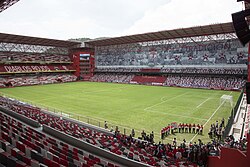The Estadio Nemesio Díez (Nemesio Díez Stadium) is one of the oldest football stadiums in Mexico. Opened on August 8, 1954, with a capacity of 27,273, it is located in barrio de San Bernardino in the city of Toluca, State of Mexico, near capital Mexico City. It is the home of Deportivo Toluca F.C. and Deportivo Toluca F.C. (women).
This stadium has hosted two Football World Cups Football World Cup 1970 and Football World Cup 1986 one Pan American Games 1975 Panamerican Games, one FIFA World Youth Championship 1983 FIFA World Youth Championship and one Central American and Caribbean Games 1990 Central American and Caribbean Games.
The stadium sits at an altitude of roughly 8,750 feet (2,670 m) above sea level, one of the highest altitude stadiums in North America. A former nuance about this stadium is that it did not have a lighting system, which forced the local team as a tradition to play at noon.
The playing field is oriented from east to west, the only professional stadium in the country located in that position. The stadium was previously known as: Estadio Toluca 70–86, Estadio Toluca 70, Estadio Luis Gutiérrez Dosal and Estadio Héctor Barraza.
The stadium was remodelled in 2017, which brought the stadium up to modern standards, expanding the capacity to 30,000 spectators, and adding technology with greater support for screens and ambient sound, all the while preserving the English style that has characterized it, such as the proximity to the playing field.
During the 1940s and 1950s, Toluca played its home games at a ground near downtown Toluca known then as Tivoli. Later, wooden stands were built in the ground and it was named Campo Patria. On that same spot, in 1953, the club started building its own stadium.
The stadium was inaugurated on Sunday 8 August 1954, with a match between Deportivo Toluca F.C. and Yugoslavian team GNK Dinamo Zagreb. The game was won by Dinamo 4–1. The only goal for Toluca and also the first in the history of the stadium was scored by Enrique Sesma.
Initially, the stadium was opened as Estadio Club Deportivo Toluca. That name lasted until 1955, when it was changed to Estadio Héctor Barraza. Other names the stadium has had are: Estadio Luis Gutiérrez Dosal (1959–1970), Estadio Toluca 70 (1970–1986), Estadio Toluca 70–86 (1986–2000).
After the death of Nemesio Díez Riega, president and then owner of the club, in June 2000, the stadium name was changed to Estadio Nemesio Díez.
The now Nemesio Díez stadium has a capacity of 30,000 spectators. The stands are divided into 4 zones, Palcos, VID Palcos, Sol General, Sombra Preferente and Sombra General. There is a transmission box for the press, television and radio located in the preferred shaded area.
Renovation (2015–2017)
edit
With an investment of 900 million MXN, the announcement to remodel The Nemesio Diez stadium by 2017 was made, when Club Deportivo Toluca celebrated its centenary and does so with a remodelled and more functional stadium.
Within the Nemesio Diez, four macro support columns that will sustain the stadium structure will be built to replace the current columns obstructing visibility. In the shadow stands, a second level will be built so the capacity, which currently stands at 22,000 will increase to 30,000.
The project also includes four giant screens at each end of the building, replacement of all seats and a sunroof in the preferred (shaded) section, to assist in the process of maintaining the natural grass in the field.
The remodelled stadium officially opened on January 15, 2017, with a league match against Club America. The first goal was scored by Gabriel Hauche for Toluca with a screamer outside the box. Toluca FC won that match 2–1.
The stadium was completed in the summer 2017 where it had been confirmed that the club would play against Atlético Madrid for the official inauguration of the remodelled stadium.
The remodeling of the stadium was carried out from 2014 to 2017, the design was carried out by Quattro + 1 Arquitectos and the structure was carried out by Lanik. The works include increasing the capacity from 27,000 to 30,000 spectators on six floors, having two basements, special boxes, electronic boards were replaced with screens and ambient sound, fiber optics, cameras, counterfeit ticket detectors, and electronic turnstiles were installed. . , the roof was remodeled to allow the viewer a clear view without obstacles, which consists of a light geometric structure of 10,000 square meters.

